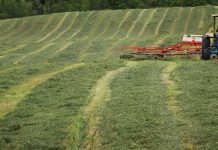Debt. A four-letter word, but not necessarily a “bad” word. The majority of Ohio’s dairy farms have debt, and it makes good business sense for them to have debt and manage it wisely.
Our farms grow when additional returns generated by a carefully planned investment made using borrowed dollars exceed the interest owed on the loan. That “growth” may be growth in farm size, or it may be growth in ability to produce milk efficiently.
We are fortunate in Ohio to have more than one lending institution that wants to have dairy farms as part of their portfolio. This gives farmers an opportunity to shop for their borrowing needs among cooperative lenders such as Farm Credit or Ag Credit, privately owned community banks as well as larger commercial banks.
Cows’ work load
Managing debt at the farm level is important to the long-term profitability of a farm, and we will wrap up our discussion of debt looking at what we ask our cows to repay each year. Our earlier discussions this year focused on what we can learn from the farm’s balance sheet. Today, we will use balance sheet information as well as the dairy farm’s total revenues to evaluate what we are asking cows to do.
Table 1 shows the repayment schedule measures from the 15 Measures of Dairy Farm Competitiveness calculated for the 35 farms that participated in the 2013 Ohio Farm Business Summary (farms are working on their 2014 analysis now).
Table 1. 2013 Ohio Dairy Farm Business Summary Repayment Schedule
| 2013 | Average of 35 Farms | Top 20% 7 Farms |
| Number of Cows | 259 | 211 |
| Debt/Cow | $4,352 | $3,769 |
| Scheduled Debt Payment/Cow | $422 | $537 |
| Scheduled Debt Payment as a % of Gross Receipts |
6.5% | 3.48% |
What numbers mean
Scheduled debt payment per cow simply takes the total scheduled principal and interest payments, plus any capital lease payments (these would be for buildings, machinery, equipment, or livestock — not land rent) for a year and divides it by the number of cows (milking and dry). These are the dollars that we are committing, up front, to making principal and interest payments from the dollars generated by a cow in our herd.
Historically, we would like to see this number at $500 per cow or less. Interestingly, the top 20 percent of farms have a higher scheduled debt payment per cow than the average of all farms. Is this a problem? We have to look at the bigger picture to decide.
When we look at the scheduled debt payments as a percentage of the farm’s gross receipts, the top 20 percent of farms are generating more dollars per cow, and 3.48 percent of their gross income is committed to scheduled principal and interest payments, nearly half of the 6.5 percent committed for all farms. With a goal of less than 15 percent of gross revenues being obligated to repaying scheduled debt (this does not include the farm’s line of credit or accounts payable), both groups of farms are in good shape in this respect.
Know your numbers?
These are just a few of the important numbers you should know about your farm business. Analysis of your farm business is available through the Ohio Farm Business and Benchmarking Program. If your farm records are good, you can start right into an analysis of 2014. The Ready, Set, Go! Program is available this year to work toward an analysis of 2015. Contact us to talk about what would work well for your farm at 330-533-5538 or shoemaker.3@osu.edu.












